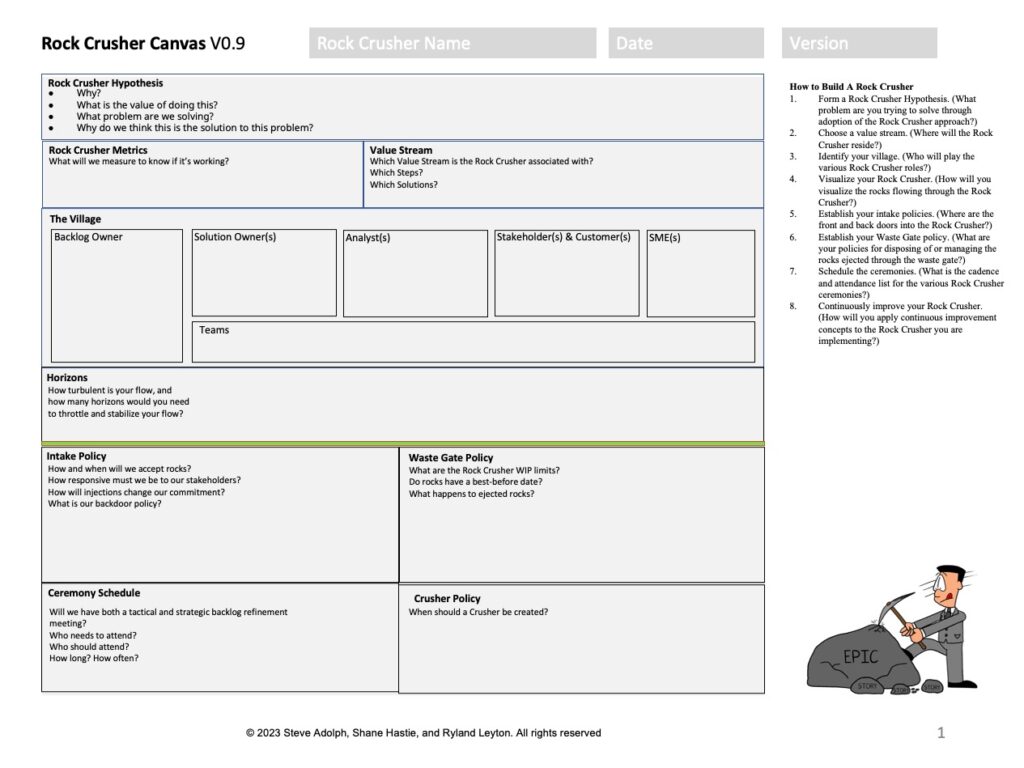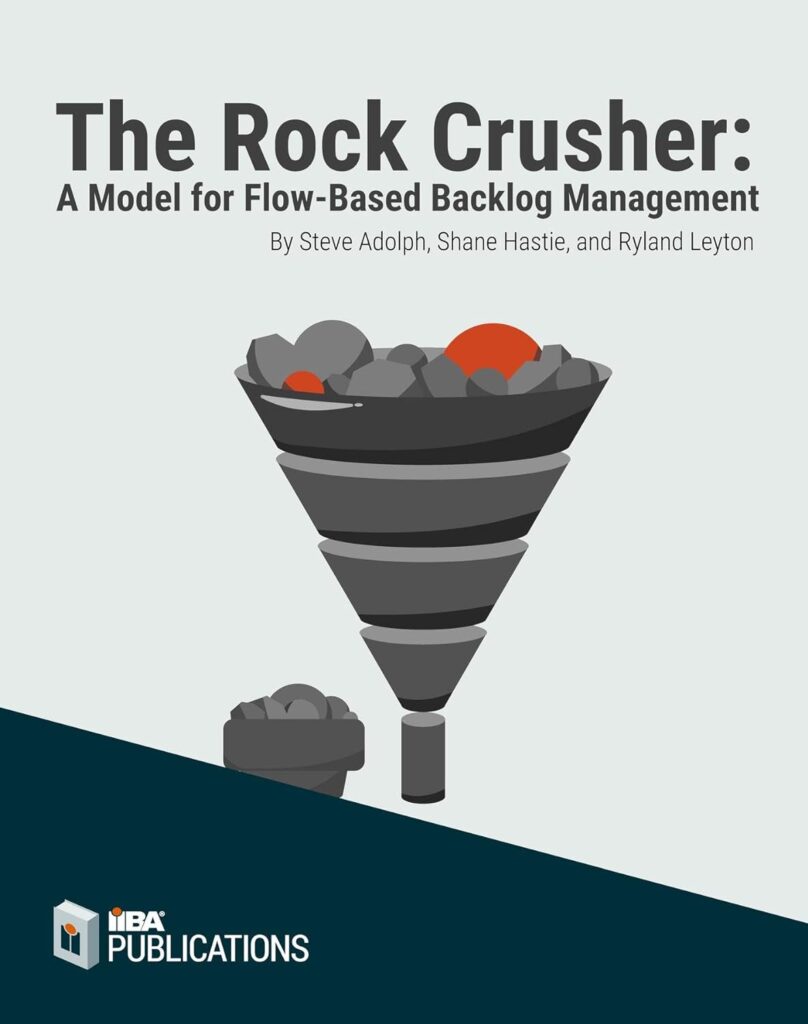
Most enterprises treat their backlog like most people treat their car’s engine as something that powers the car and can be safely ignored beyond taking it in for regular service.[1]. Like our automobile engine, the backlog powers our team. It is the single repository from which a team can pull their next most valuable work. Unlike the automobile engine, ignoring it leads to low economic performance. Unfortunately, most organizations ignore their backlog, treating it as a passive reservoir of pre-committed requirements. In a blog post by Steve Adolph ( What did 50 Business Analysts Say Were their Biggest Challenges with Backlog Management?), some 50 business analysts described the problems they were experiencing with their backlogs. Many of the problems could be distilled down to a lack of active backlog management and clarity on responsibilities for backlog management.
This is why my co-authors and I wrote “The Rock Crusher” to explain how the traditional backlog management model, which we labeled the stack of plates model, breaks the value stream and impedes flow. This has severe economic consequences for an enterprise. The worst part of these consequences is that they do not visibly manifest themselves as some general ledger item. Rather, they manifest as lost competitiveness, declining market share, lost goodwill, and staff turnover. (See It’s not all about costs, its about all costs at Steveadolph.com )
The key theme in The Rock Crusher is using our backlog to actively manage the flow of value rather than merely serving as a passive reservoir of requirements. A system for active value management is significantly more complex than a passive reservoir and needs careful design and management. This is why we offer you the Rock Crusher canvas to help you design and improve your backlog management.
These days, it’s become de rigueur to call everything to help you organize your thoughts and ideas a “canvas.” But that is exactly what the Rock Crusher Canvas is for. Based on The Rock Crusher chapter 15 – Implementing Your Rock Crusher, the canvas walks you through the 8 steps for using the Rock Crusher model to think about how to build a better backlog.
- Why the Rock Crusher? Form a Rock Crusher Hypothesis describing the problem you are trying to solve, how the rock crusher will solve it, and what data you need to collect to validate or reject your hypothesis.
- Choose a value stream. (Where will the Rock Crusher reside?)
- Identify your village. (Who will play the various Rock Crusher roles?)
- Visualize your Rock Crusher. (How will you visualize the rocks flowing through the Rock Crusher?)
- Establish your intake policies. (Where are the front and back doors into the Rock Crusher?)
- Establish your Waste Gate policy. (What are your policies for disposing of or managing the rocks ejected through the waste gate?)
- Schedule the ceremonies. (What is the cadence and attendance list for the various Rock Crusher ceremonies?)
- Continuously improve your Rock Crusher. (How will you apply continuous improvement concepts to the Rock Crusher you are implementing?) Goto 1
These eight steps ask how we will apply lean and agile thinking with our backlog to create the best economic outcomes for our enterprise. We’ll try to keep this article short by just looking at a few of the key steps for designing a Rock Crusher.
Step 1 Why the Rock Crusher?
The first step is the most important. Ask, “Why the Rock Crusher”? Before you start disrupting and transforming your way of working, can you clearly state the problems you are experiencing with your present backlog management strategy and how the Rock Crusher approach may mitigate them? Most importantly, how will you know if it is working? What leading indicators could you measure to test your hypothesis? Do not adopt the Rock Crusher because it seems cool. Adopt it because you believe it can help you solve a problem.
Step 3 Who is part of the village?
Our assertion is it takes a village to manage a backlog and that backlog management is far too complex and demanding to rest on one individual’s shoulder – usually, the poor person designated as the “product owner.” The Rock Crusher Village <see It Takes a Village to Own a Product> identifies seven collaborative roles for managing a backlog and deciding on “precisely what to build.” One of the most important outcomes of this step is identifying the Backlog Owner and Solution Owner(s). Are the Backlog and Solution Owners the same or different individuals? Are there multiple Solution Owners? How will the Backlog Owner and Solution Owner collaborate if they are different individuals? Who is responsible for supporting them? Who plays the role of the Analyst? Who are our Subject Matter Experts? Who do we need to input from to guide our decision making? Who are our stakeholders and customers? Could you clearly answer these questions now in our context? For example, do you know if the individual playing the role of Product Owner in your environment is a Backlog Owner, a Solution Owner, or both? This is the clarity the Rock Crusher canvas helps us establish. It shows who how content authority may be scattered across multiple individuals and makes conflicting overlaps visible.
Step 6 is establishing Waste Gate Policy.
The Waste Gate is a distinguishing trait of the Rock Crusher. The Rock Crusher has a pithy definition for flow: what goes in, must come out. Far more ideas enter the Rock Crusher than a team can deliver. If we are to have a relentless focus on value delivery, then we need to drain away the less valuable ideas. If you were to look in your backlog right now, how many user stories are over 100 days old? 500 days old? 1000+? Unfortunately, if you have numerous stories that are over 1000 days old, you’re in good company. Numerous enterprises have stagnant backlogs. One of the best quotes about value creation comes from American economist Michael Porter: “Strategy is the art of knowing what not to do.” The humble waste gate is your powerful strategy tool for draining away what you are not going to do.
Step 8 Continuously Improve your Rock Crusher
Finally, step 8 makes it clear the way we work together is agile, which means we embrace change. Just as we experiment, learn, and improve our product, we experiment, learn, and improve our way of working.
To Learn More
This is still a draft version, and we are working with the IIBA to create a more visually pleasing Rock Crusher Canvas.
Of course, if you get a copy our book chapter 15 provides a detailed description of the eight steps for designing and evolving a Rock Crusher.
[1] As an old petrolhead who used to maintain his car (69 Dodge Dart with the 225 slant six engine), I would not dare touch a modern engine. I hate to say it, but that takes all the fun out of owning a car.
